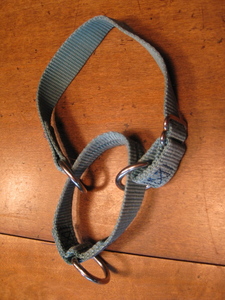 I consider the martingale collar a dog trainer’s best kept secret. Very few people have heard of it and understand its benefits. I often suggest it for dogs taking my therapy dog training classes and bring the sample pictured at the left to show people what it looks like.
I consider the martingale collar a dog trainer’s best kept secret. Very few people have heard of it and understand its benefits. I often suggest it for dogs taking my therapy dog training classes and bring the sample pictured at the left to show people what it looks like.
The martingale provides the little extra control needed for many dogs in early stages of training. Rest assured, it does not operate like a choke collar. It gives a gentle squeeze – not a choke. And, unlike the traditional snap buckle collar, you’re not tugging on the dog’s neck.
Because it’s not a popular training collar, it may be hard to find in pet supply stores – and, I have found, there are a few varieties on the market… only ONE is correct. Here’s what you should be looking for: as seen in the above photo, there are two loops. The top loop with two rings goes around the dog’s neck and the bottom loop with one ring is where the leash is attached. It is of the utmost importance that the neck loop be adjustable (see slider on the right side of the neck loop in the photo). The slider is used to adjust the neck loop so that the two rings are separated by about three inches around the dog’s neck. People often make the mistake of making the neck loop too large, leaving the two rings coming together. In so doing, the martingale is useless.
How the martingale works… provided the two rings on the neck loop are separated by about three inches, when the trainer gives a slight pull on the lead to indicate direction, the dog receives a gentle squeeze on the neck – as opposed to a tug on the neck which a traditional snap bucket collar would give. Results are excellent. I use the martingale on any of my dogs who need extra control.
A word of caution, however… the martingale should not be kept on your dog’s neck at all times, as you might keep on a traditional collar. It is possible for the leash loop to get caught on something when your dog is outside playing or when crated – for example. The martingale should be put on for training, loose lead walking, or when you need the security of a non-slip collar.
Extra bonus – can’t slip out… The martingale is often referred to as the Greyhound collar because – when fitted properly – a dog cannot slip out of a martingale collar as they can with a traditional collar. Most Greyhounds and Whippets sport martingales so they won’t slip out and run, run, run… I have used martingales on my therapy dogs when we used to visit a facility in the city. They didn’t need the control of a martingale – but I needed the peace of mind that they couldn’t accidentally slip their collar in the middle of the city.
Leave a Reply